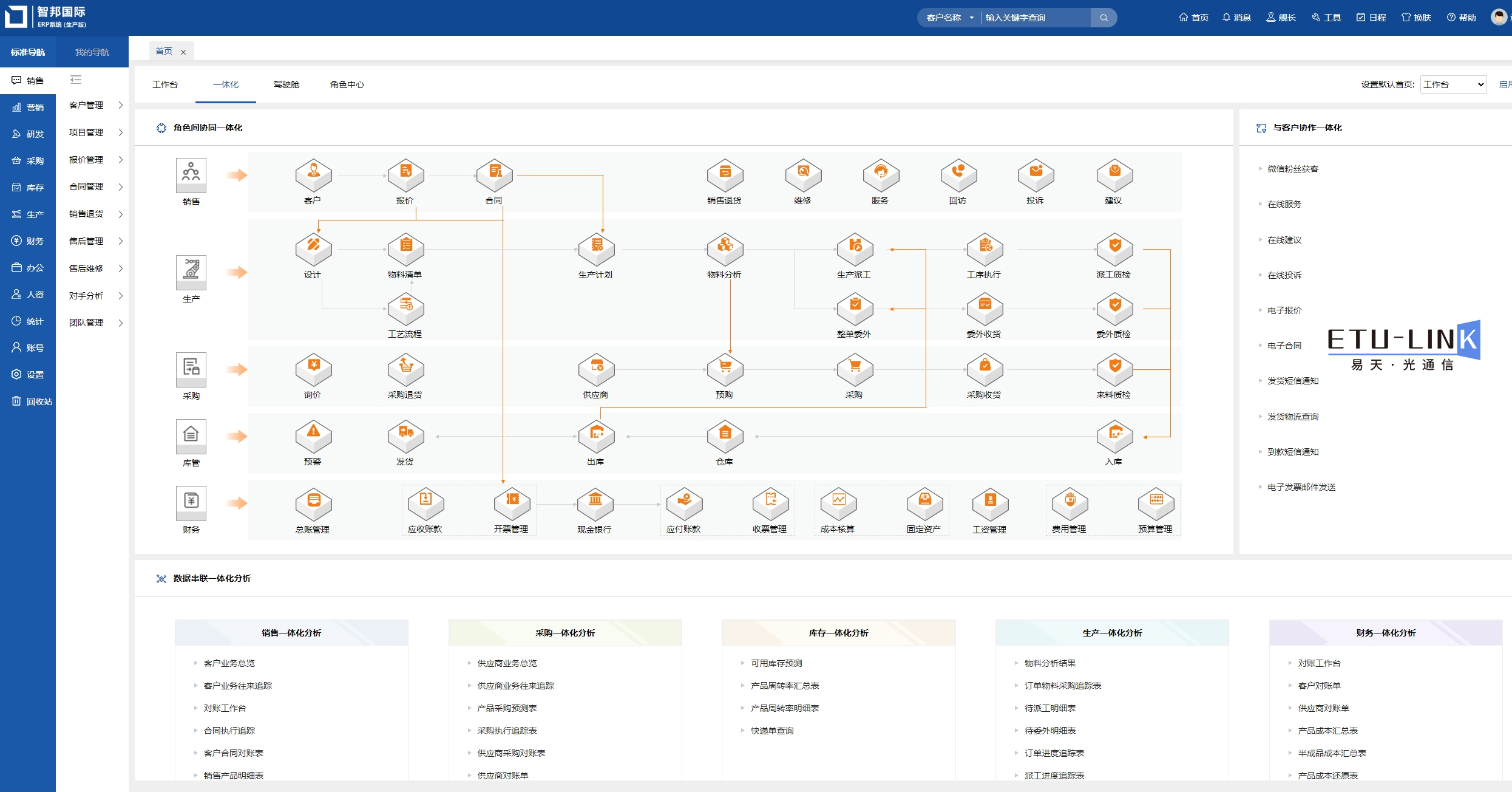
ETU-LINK construye completamente sistemas ERP y MES Diseño estratégico para avanzar en la transformación digital
Driven by the wave of digitalization, enterprises have an increasingly urgent need to improve production efficiency, optimize resource allocation and reduce operating costs. ERP management software is like a link, planning procurement, production, cost, inventory, distribution, transportation, finance and human resources, so as to achieve the best combination of resources and achieve the best benefits. As early as 2019, ETU-LINK has fully activated the ERP system. For optical communication enterprises integrating research, manufacturing and marketing, it is not an easy thing to integrate the process interfaces between the enterprise layer and the workshop production management management in the case of continuous refinement of production and planning unit requirements, and MES is a good supplement to the ERP system. Recently, MES systems have also been put into use within the ETU.
I.Overview of ERP and MES systems
ERP system is a kind of enterprise management software, covering financial management, procurement management, inventory management, production management, sales management and other modules, aiming to integrate the internal resources of the enterprise, improve work efficiency and decision-making ability. The MES system is used to manage and monitor the workshop production activities of the system, the main functions include production planning and scheduling, production process control, quality management, equipment management, etc. The combination of the two enables informationization and digitization of the entire process, from supply chain management to production floor execution.


II.Limitations of ERP system
ERP system has significant advantages in resource scheduling and information integration at the macro level, and can efficiently deal with static resource data within ETU, such as order management and inventory control. However, when it is necessary to go deep into the production line and grasp the dynamic information such as production progress, equipment operating status and material consumption in real time, the limitations of the ERP system appear. Designed primarily to support resource planning and decision making, rather than real-time data acquisition and monitoring, it lacks front-line execution and feedback, so building integration between the two systems is necessary in this context.

III. Advantages of sound ERP and MES systems
Real-time data collection monitoring and resource allocation
The improvement of ERP and MES makes up for the gap in real-time data acquisition of the former, and the MES system is like a monitoring device installed for the production site, so that the management can intuitively view the real-time status of each process, and timely feedback the real-time data in the optical module production process to the ERP system, such as equipment status, production progress, process parameters, etc. It enables the planning department to adjust the production plan in real time, optimize the allocation of resources, and realize the fine and efficient production management.

Quality management and automated data tracing
In terms of product quality control, the advantages of MES system are particularly prominent. It can not only monitor the quality indicators in the production process in real time, achieve instant warning of quality problems, but also trace every production link of optical module products from raw materials to finished products, once the problem is found, it can quickly locate the source and take corrective measures in time, so as to effectively improve product quality and customer satisfaction.
Production process coordination and control
ERP is handy in macro control, while MES is accurate in micro execution. The coordination of the two ensures the reasonable planning of resources and the smooth execution of the production process. The meticulous coordination of MES on the production process allows the ERP plan to be accurately landed, thus realizing the closed-loop management from macro planning to micro execution.
Process and standardization construction
The ERP system mainly manages the production, procurement, inventory and other information of the enterprise, while the MES system can collect and process the production data in real time. The integration of the two can realize the comprehensive integration of production data and management data, and then realize the optimization of data flow.
Through the integration of production data and management data, production planning, bill of materials management, production scheduling and other work can be better carried out internally, greatly reducing the expenditure of manpower, material, financial and time costs, and realizing the optimization of production processes and the improvement of efficiency.
Improvements in information technology infrastructure
The combination of ERP and MES effectively improves the information technology infrastructure of ETU-LINK, realizes the centralized management of internal information and data, reduces the time of information and data in internal circulation, and improves the work efficiency to a great extent.
Improvement of operation process and production efficiency
La integración de los dos puede mejorar el proceso de operación existente, llevar a cabo una operación estándar integrada de la base de la sede y la fábrica de ETU-LINK, y desempeñar una buena guía para la operación y el proceso de los trabajadores del taller, estandarizar la producción del taller. , acorta efectivamente el ciclo de producción y mejora en gran medida la eficiencia de la producción laboral.
Gestión financiera y estadísticas de informes.
En términos de gestión financiera, se pueden agregar las funciones de actualización diaria de datos del sistema financiero y estadísticas en tiempo real de los estados de gestión para lograr el objetivo de cierre diario y proporcionar información financiera más precisa y oportuna para ETU.
En resumen, el sistema integral ERP y MES de ETU-LINK es una medida importante para que nuestra empresa promueva la transformación digital y mejore la competitividad central. Por medio de la tecnología de la información, ETU no sólo optimiza los procesos de gestión interna, sino que también mejora la eficiencia de la producción y la calidad del producto. En el futuro, ETU-LINK continuará profundizando la construcción de información, continuará innovando y progresando, y continuará contribuyendo a la transformación digital de las empresas.
© Derechos de autor: 2025 ETU-Link Technology CO ., LTD Reservados todos los derechos.

Soporta red IPv6